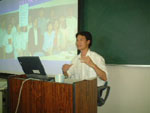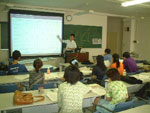The 1st WORKSHOP 5 July 2003 (Sat), Tokyo 14:00- |
|||
| Subject: Human
Capital, Poverty Trap and Industrialization
by Mr Do Ngoc Huynh |
|||
|
Mr. Huynh presented his paper, which was a work in progress, using power point. The paper contained three parts: model, policy implications, and empirics. In the first part, an overlapping generations model with the traditional and modern sector was presented. By assuming a threshold level of human capital required to work in the modern sector, the model shows that smooth growth occurs in the modern sector while workers in the traditional sector are caught in a poverty trap. In the second part, policy measures including education loans, redistribution through taxes and subsidies, public supply of education, etc. were evaluated. In the third part, empirical analyses using international and Vietnamese provincial data were presented. A question was raised about the shape of the utility function which excluded inter-generation love (children's consumption does not enter the parent's utility). It was argued that the parents act as a special "bank" for children without moral hazard or monopoly bargaining. This could be considered an implicit "love" between them in this model. Some asked why parents always invest in children (and not physical capital) on a priority basis. The model assumed homogenous agents. A participant asked whether the results would still stand if heterogeneity was introduced (some children are better students than others). The presenter could not answer immediately, but it might be possible to show a poverty trap even if children's quality varied. Even good pupils must drop out of school if the parents are poor. The possibility of mobility between the two sectors was suggested. In this connection, it was noted that Vietnam's poor were clustered around the poverty line and they went up and down frequently depending on the luck in job, health, family trouble, etc (World Bank, based on household survey). Under such circumstances, general growth might be more effective than direct poverty-targeting. As to the empirical part, it was suggested that the linkage between model and empirics was weak. Personal poverty cannot be easily extended to international or provincial poverty. Some argued that highly educated people would come to Hanoi or HCMC to live, although they might have received provincial high school education. This might cause bias in the provincial regression. Many questions were directed to the validity of the policy proposal. Some noted that investing in physical as well as human capital might contribute to the solution. Similarly, investment in the modern sector might be effective in solving the poverty problem. Others pointed to the possibility that, if more people demanded education, its price would rise and, perversely, less people could afford it. It was also argued that education might not solve the problem if there were no jobs upon graduation. Some contended that policy proposal was too general, and prioritization under budget constraint was necessary. The idea of education credit financing system for Vietnam was also discussed.
|
|||

